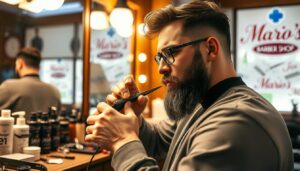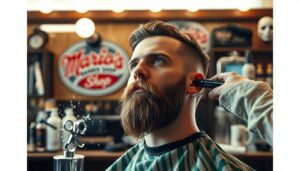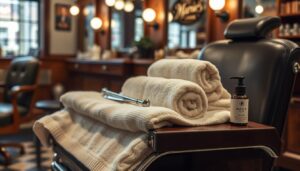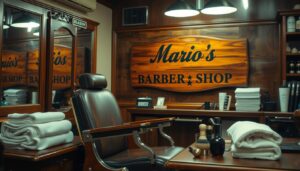Do you struggle to maintain a well-groomed and healthy beard? Discover the secrets to effortless beard trimming and grooming in this comprehensive guide. Whether you’re a seasoned beard enthusiast or just starting your facial hair journey, we’ve got you covered with the essential tools, techniques, and tips to help you achieve the perfect beard.
From mastering the basic trimming methods to exploring advanced sculpting and fading techniques, this article will empower you to take control of your beard and showcase it with confidence. Dive in and uncover the secrets to keeping your facial hair looking its absolute best, no matter the occasion.
Essential Tools for Professional Beard Grooming
Achieving a well-groomed, healthy beard requires the right tools. As part of your beard grooming routine, investing in quality trimmers, scissors, combs, and beard oils is essential. Proper trimmer maintenance is key to ensuring a precise, clean trim every time.
When selecting a beard trimmer, look for one with adjustable guards and a powerful motor that can handle even the thickest facial hair. Regular cleaning and oiling of the trimmer blades will extend their lifespan and maintain their sharpness. Pairing your trimmer with a high-quality pair of scissors can help shape and detail your beard, allowing you to achieve a professional finish.
A wide-toothed comb is a must-have for detangling and styling your beard. Use it to distribute beard oils and balms evenly, ensuring your facial hair stays soft, manageable, and nourished. Investing in a selection of beard oils and balms can also help tame flyaways, reduce itchiness, and promote healthy beard growth.
By assembling the right toolkit and maintaining your trimmer, you’ll be well on your way to achieving a salon-quality beard grooming routine at home. With the proper tools and techniques, you can keep your facial hair looking its best.
Beard Trimming 101: Basic Techniques for Beginners
Cultivating a well-groomed beard is an art form, and mastering the basics is key for novice groomers. Whether you’re aiming for a classic full beard or a meticulously sculpted style, understanding the fundamentals of beard trimming is essential. In this section, we’ll explore the essential techniques that will help you maintain a clean, healthy, and fashionable facial hair look.
First and foremost, proper tool handling is crucial. Invest in a high-quality trimmer or electric shaver designed specifically for facial hair. Familiarize yourself with the various attachments and settings, and always be gentle when navigating around your facial features. Proper technique and a steady hand will ensure a clean, even trim every time.
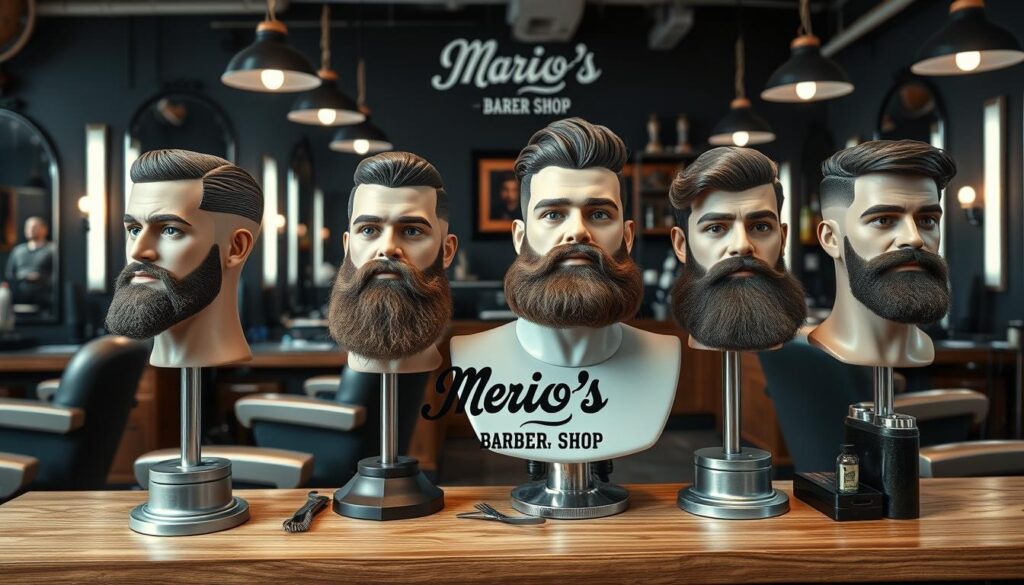
Next, learn to trim different facial hair styles. For a classic full beard, use the trimmer to gradually reduce the length, working from the cheeks and neckline inwards. For a more sculpted look, use the trimmer’s edge to precisely define the beard’s shape and contours. Experiment with various lengths and styles to find your perfect facial hair style.
Incorporating essential grooming techniques, such as combing and brushing, will help train your facial hair and maintain a polished appearance. Invest in a high-quality beard comb or brush to groom your facial hair in the desired direction, ensuring an even and cohesive look. With regular maintenance and a bit of practice, you’ll soon master the art of beard trimming and achieve a professional, groomed appearance.
Understanding Your Facial Hair Growth Pattern
Achieving a well-groomed beard starts with understanding your unique facial hair growth pattern. Each person’s beard grows differently, with variations in density, direction, and rate of growth. Recognizing these individual characteristics is crucial for mastering beard grooming and maintaining a symmetrical, healthy appearance.
One of the key factors to consider is the direction of your beard hair growth. Some men may have a growth pattern that sweeps upward, while others experience a downward growth. Identifying this directionality will guide you in choosing the right beard trimming techniques and ensuring an even, polished look. Additionally, paying attention to the density of your facial hair can help you determine the optimal beard length and styling approach.
Understanding your facial hair growth pattern will also help you establish a consistent beard grooming routine. By knowing how your beard typically grows, you can tailor your trimming and maintenance regimen to achieve the desired shape and length. Regularly examining your facial hair and adjusting your beard grooming habits accordingly will ensure your beard stays looking its best.
Embracing the unique characteristics of your facial hair growth is the first step towards achieving a well-groomed, polished beard. By becoming familiar with your individual pattern, you’ll be equipped to navigate the world of beard grooming and maintain a look that perfectly complements your features.
Establishing Your Perfect Beard Length
Achieving the perfect beard length is a delicate balance between personal style and face shape. Whether you prefer a rugged stubble or a full, lush mane, understanding how to utilize trimmer attachments can be the key to maintaining your desired facial hair look.
When it comes to trimmer attachments, the options are vast – from precision edgers to wide-set guards, there’s a tool for every beard style. Experiment with different attachments to find the one that best complements your facial hair growth pattern and desired length. A shorter guard can help you achieve a neat, uniformed stubble, while a longer attachment can unleash your inner mountain man.
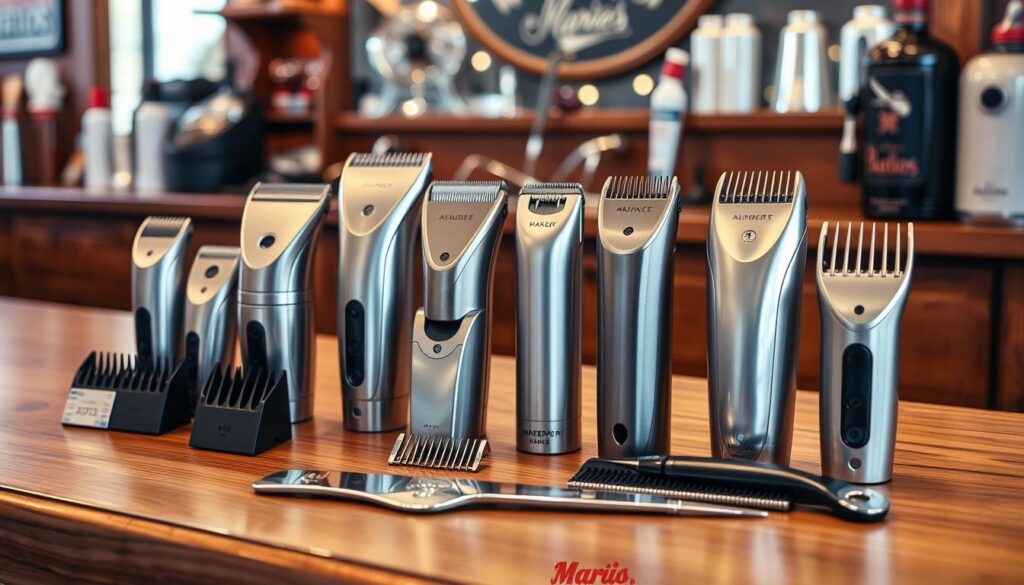
As you establish your perfect beard length, pay close attention to the density and direction of your facial hair. Some men may find that a longer beard flatters their face shape, while others may prefer a more tailored, closely cropped look. Regularly using your trimmer attachments can help you maintain consistent length and prevent unruly growth, ensuring a polished, well-groomed appearance.
Embrace the journey of finding your signature facial hair style. With the right trimmer attachments and a little practice, you’ll be on your way to rocking the perfect beard length that accentuates your unique features and personal flair.
Mastering the Beard Neckline and Cheek Lines
One of the keys to maintaining a well-groomed beard is mastering the art of trimming the neckline and cheek lines. These critical areas can make or break the overall appearance of your facial hair, so it’s essential to get them right. By learning proper beard neckline and beard sculpting techniques, you can achieve a clean, defined, and professional-looking beard that complements your facial features.
Start by determining your natural beard neckline, which is typically about one to two inches above your Adam’s apple. Use a trimmer or razor to create a clean, sharp line that follows the contours of your neck. Be careful not to trim too high, as this can result in an unnatural, sculpted look. Gradually work your way up, checking the progress to ensure you achieve the perfect neckline.
Next, focus on the cheek lines. The goal is to create a symmetrical, well-defined shape that enhances your facial structure. Use a trimmer or razor to follow the natural curve of your cheeks, starting from the corner of your mouth and working your way up to the sideburns. Maintain a consistent line and avoid creating harsh angles, as this can appear unnatural.
Remember, mastering the beard neckline and cheek lines takes practice and patience. Experiment with different techniques and adjust as needed to find the perfect balance that suits your face shape and personal style. By taking the time to perfect these essential grooming habits, you’ll be on your way to a flawless, well-sculpted beard that turns heads.
Advanced Beard Sculpting and Fading Techniques
Elevate your beard grooming game with advanced sculpting and fading techniques. Mastering these expert methods will help you achieve professional-looking, seamless transitions between different beard lengths and create striking, tailored styles. Whether you’re aiming for a clean, sharp edge or a soft, gradual fade, the right techniques can transform your facial hair.
Begin by understanding your unique facial hair growth patterns. This knowledge will guide you in determining the optimal lengths and shapes for your beard. Use precision trimmers and fading techniques to gradually reduce the length from the neckline and cheeks, blending your facial hair for a polished, tapered appearance.
Sculpting your beard involves carefully shaping the edges and defining your desired look. Use a high-quality trimmer with adjustable guards to precisely trim and contour your facial hair. Experiment with different guard sizes to create clean lines and sculpted dimensions that complement your face shape.
Fading techniques, such as feathering and blending, are essential for achieving a natural, cohesive look. Start with the longer sections of your beard and gradually reduce the length, carefully blending the transitions to avoid harsh lines. This creates a seamless, professional-grade finish that will elevate your overall grooming game.
Daily Beard Maintenance and Grooming Routine
Maintaining a well-groomed beard is essential for keeping your facial hair looking its best. A daily beard grooming routine can help you achieve this, ensuring your beard stays healthy, vibrant, and perfectly shaped. Let’s explore the key steps to incorporate into your daily beard maintenance regimen.
Proper washing and conditioning are the foundation of any beard grooming routine. Use a gentle, sulfate-free beard wash to cleanse your facial hair, followed by a nourishing beard conditioner to keep it soft and manageable. Gently pat your beard dry with a clean towel, being careful not to rub it too vigorously.
After washing and conditioning, it’s time to style your beard. Apply a small amount of beard oil or balm to your palms and gently massage it into the hair and skin. This will help tame flyaways, add shine, and keep your beard looking its best throughout the day. Remember to use a high-quality, natural product specifically formulated for beard care.
Finally, regular trimming is essential for maintaining the shape and health of your beard. Use a sharp pair of beard scissors or trimmers to tidy up any stray hairs and keep your neckline and cheek lines well-defined. Aim to trim your beard every 2-4 weeks, or as needed, to ensure it stays looking its absolute best.
Troubleshooting Common Beard Trimming Issues
Maintaining a well-groomed beard can be a rewarding experience, but it’s not without its challenges. In this section, we’ll address some of the most common beard trimming issues and provide practical solutions to help you achieve flawless results.
Uneven beard growth is a common frustration for many men. Whether it’s patchy areas or inconsistent length, the key is to identify the root cause and adjust your trimming techniques accordingly. Proper use of your trimmer, understanding your facial hair growth patterns, and regularly conditioning your beard can all contribute to a more uniform appearance.
Another common problem is dealing with stubborn stray hairs. While these errant strands may seem like a minor annoyance, they can disrupt the overall symmetry of your beard. Employing precise trimming methods, such as using the edging attachment on your trimmer or carefully sculpting the perimeter, can help reign in those troublesome hairs and maintain a clean, well-defined look.

